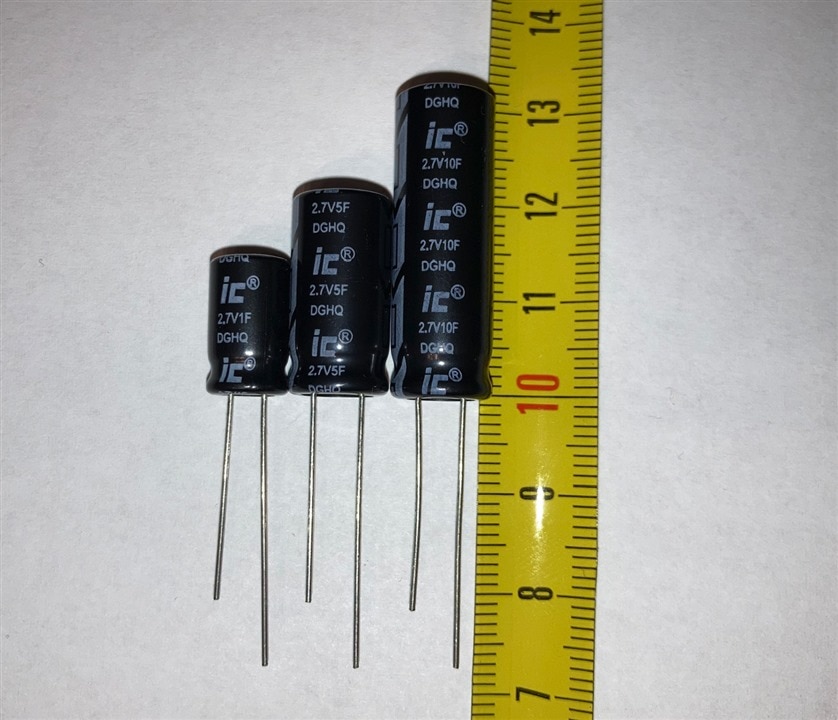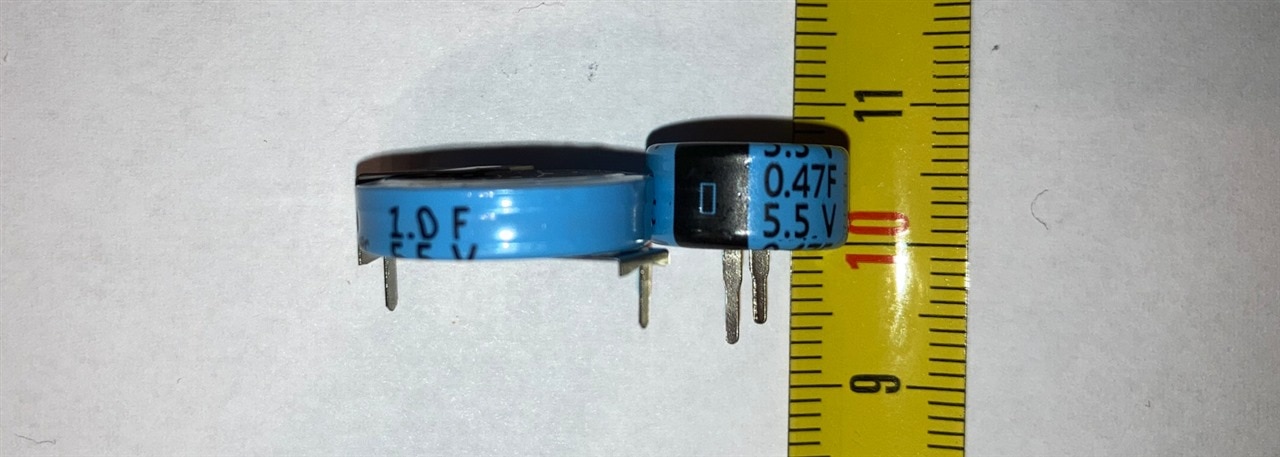Hello everyone. I welcome you to my first blog as part of Experimenting with Supercapacitors design challenge. Before I start publishing details about my ongoing experiments, I want to describe capacitors which I play with. This first blog will be only about them. Recently I received following kit containing 13 capacitors and 2 pieces each resulting in total of 26 capacitors:

As you can see, there are several capacitor types differing in several parameters and some parameters differences are visible on the image above (for example, size and package type).
Most supercapacitors have Illinois Capacitor logo on it. Illinois Capacitor is company which developed and manufacture these supercapacitors, but it was acquired by Cornell Dubilier, and they are rebranding these capacitors now. I have some of these caps in the basket and distributor send me Product Change Notice (PCN) document about this rebranding, but it does not contain any details about timing of such change. It only says that it is happening now. In my experiments I will all of them refer under Cornell Dubilier (CDE) brand because in the future you will see them under this brand.
Capacitors families (types)
The kit contains Cornell Dubilier capacitor from 6 families:
- DGH
- DSF
- EDC
- EDS
- VMF
- VPF
While it looks like random letters, naming convention have some system. Capacitors starting by D are black standard Radial capacitors. Capacitors starting by E are coin capacitors (blue caps on the image above) and capacitors starting with V look exactly the same as capacitors starting with D at the first look, but internally they are significantly different – they are based on lithium and offers very large capacitance (25F and 40F are in the kit) while their size is pretty small. On the picture above they are in the cells 8, 9, and 10. 40F is the largest capacitance which I have in the kit, but it is not largest capacitor in terms of psychical dimensions. The largest capacitor is 25F capacitor from DSF family.
Cornell Dubilier offers some other families. The families containing supercapacitors, which we received are mentioned as “Recommended for new design” while the families from which we did not received any supercapacitor are referred just as “active”. Generally, families follow the naming convention above. Some older supercapacitors which I will not work with are from DCN, DCR and DER families.
Now let’s look at details of all families.
DGH Family

From DGH family I received 3 units:
- 1F: DGH105Q2R7
- 5F: DGH505Q2R7
- 10F: DGH106Q2R7
They are based on the same technology. They have almost all shared properties. Physical dimensions of supercapacitor grow per capacity. DGH families offers EDLC capacitors which are capacitor which most people realize when hearing “supercapacitor” term. They are rated to the 2.7V and according to documents from CDE, they are suitable and recommended for application requiring low ESR and thus fast charges and discharges. Cornell Dubilier offers two tolerance grades. Units which I received are Q grade meaning tolerance of -10 to +30%. Alternative grade is M grade which have tolerance -20 to +20%.
DSF Family

From DSF family I received following 3 units:
- 3F: DSF305Q3R0
- 7F: DSF705Q3R0
- 25F: DSF256Q3R0
They are shorter in length but wider in comparison with DGH family. Their basic properties are similar to DSF, but they are rated to higher voltage 3V vs 2.7V. This indicates that they are internally implemented using different technology but resulting parameters are very similar. ESR is very similar according to documentation CDE documents and recommended applications are the same as in case of DGH family. The benefit of DSF is higher energy density because of higher rated voltage. CDE mention +24% and I want to do experiments in this area, so I will try to evaluate this difference in real.
EDC Family

From DSF family I received following 2 units:
- 0.47F: EDC474Z5R5C
- 1F: EDC105Z5R5H
Their form factor is different from already mentioned. They are designed to replace coin batteries like CR2032. In many applications this replacement is suitable and compatible form factor is very nice benefit. For this reason, typical applications completely different in comparison with previously mentioned DGH and DSF families. Tolerance also differs. In case of EDC family all supercapacitors have tolerance grade Z meaning -20% to +80%. These supercapacitors are available only in smaller capacitances up to 1.5F in comparison with for example DGH which CDE offers in capacities up to 600F. ESR of these supercapacitors is about 1000 time higher in range of tens of ohms in comparison with DGH and DSH supercapacitors which has ESR in range of tens of miliohms. But for typical applications of such supercapacitors like RTC CR2032 battery replacement, ESR is not very important. As a benefit they are rated to high voltage of 5.5V.
EDS family

The other family with similar form factor to previously mentioned one is EDS family. I have two EDS supercapacitors:
- 0.1F: EDS104Z5R5C
- 0.22F: EDS224Z3R6H
The family is very similar to EDC but there are small differences. For example, EDS support larger temperature range and has different rated voltage. It is interesting because in this case two units from the same family have different rated voltage. 0.1F unit is rated to voltage of 5.5V and 0.22F is rated up to voltage of 3.6V. This by the way indicates that efficient energy capacity can be similar and this is also indicated by price. Both capacitors cost almost the same money even one of them have more than twice the Farad capacity, but lower voltage rating.
VMF family

I received 2 supercapacitors from VMF family:
- 25F: VMF256M3R8
- 40F: VMF406M3R8
VMF is one of the family containing special lithium-ion capacitors (LIC). These capacitors offer very large capacitances in smaller form factor but have several pitfalls like they have minimum voltage requirement. Like li-ion batteries there should not be undercharged, thus they cannot be easily fully discharged and shorted. The little issue is that they were shorted during the transport because box container two loose parts and terminal of one cap shorted two terminals of the other unit and so on. We discussed this on forum: Voltage of Your VMF/VPF LIC Supercapacitors? Three of my six LIC I received undercharged and their properties possibly degraded. I marked them and I will pay special attention when experimenting with them.
Generally, LIC share some properties of capacitors and some properties of li-ion batteries. They can be charged and discharged significantly faster than batteries. Their capacity is smaller than capacity of battery but still larger than normal capacitors and comparable to EDLC supercapacitors while remaining very small size. Their ESR is about 20 times larger than EDLC, so they are not very suitable to fast transients and pulses, but they still share most recommended applications with DGH and DSF families.
VPF family
From VPF family I received one unit:
- 40F: VPF406M3R8
It is almost the same unit as 40F in VMF family mentioned above. The only difference between parts is different temperature range, otherwise they have all parameters the same.
Summary
And this is all from this blog. VPF is the last family which I will play with. In this blog I summarized and basically described kit supercapacitors and their types and basic properties. At this time, I am working on my experimental approach of measuring capacitance and most probably my next blog will show you more details about my progress.
Next blog: Measuring Large Capacitance using Python


-

misaz
-
Cancel
-
Vote Up
0
Vote Down
-
-
Sign in to reply
-
More
-
Cancel
Comment-

misaz
-
Cancel
-
Vote Up
0
Vote Down
-
-
Sign in to reply
-
More
-
Cancel
Children